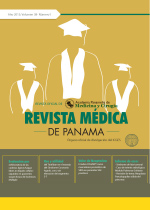Localización preoperatoria guiada por tomografía computada de nódulo pulmonar con verde de indocianina para resección toracoscópica uniportal asistida por robot. Reporte de caso
Autores/as
DOI:
https://doi.org/10.37980/im.journal.rmdp.20221885Palabras clave:
Verde de indocianina, cirugía asistida por robot, toracoscopía, radiografía intervencionalResumen
Introducción: El abordaje del nódulo pulmonar solitario tiene como objetivo la detección temprana del cáncer de pulmón en donde la resección quirúrgica es la piedra angular del tratamiento. La tecnología de imagen por fluorescencia combina un agente excitable en el espectro de luz cercano al infrarrojo y un sistema para visualizar selectivamente un tejido diana que permite su localización intraoperatoria. Caso clínico: Varón de 72 años fumador con un nódulo pulmonar de 9 milímetros con patrón en vidrio deslustrado en el lóbulo inferior derecho localizado bajo guía tomográfica con verde de indocianina y tratado mediante resección sublobar con linfadenectomía sistemática asistida por robot con abordaje uniportal. Conclusión: La técnica de marcaje preoperatorio con verde de indocianina y tecnología de imagen por fluorescencia es un método seguro y preciso que permite la identificación intraoperatoria de un nódulo pulmonar solitario durante la cirugía de mínima invasión.
Archivos adicionales
Publicado
Número
Sección
Licencia
Derechos de autor 2022 Infomedic Intl.Derechos autoriales y de reproducibilidad. La Revista Médica de Panama es un ente académico, sin fines de lucro, que forma parte de la Academia Panameña de Medicina y Cirugía. Sus publicaciones son de tipo acceso gratuito de su contenido para uso individual y académico, sin restricción. Los derechos autoriales de cada artículo son retenidos por sus autores. Al Publicar en la Revista, el autor otorga Licencia permanente, exclusiva, e irrevocable a la Sociedad para la edición del manuscrito, y otorga a la empresa editorial, Infomedic International Licencia de uso de distribución, indexación y comercial exclusiva, permanente e irrevocable de su contenido y para la generación de productos y servicios derivados del mismo. En caso que el autor obtenga la licencia CC BY, el artículo y sus derivados son de libre acceso y distribución.






